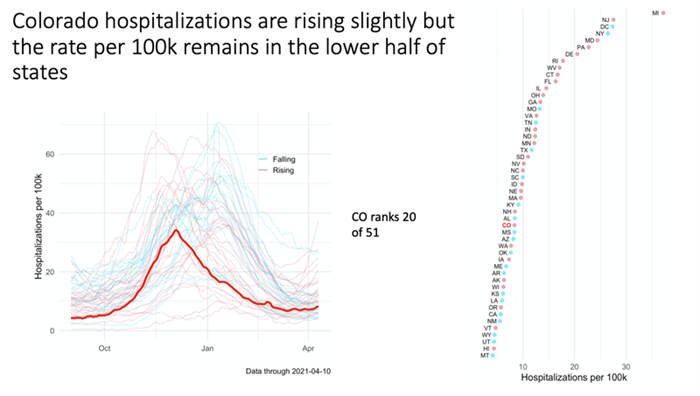The COVID-19 Pandemic: The pandemic reignites, the J&J pause, and county confusion
Apr 19, 2021
The pandemic persists, although too many Coloradans are “over it.” Hospitalizations continue to rise, maintaining the age pattern I mentioned last week: rising numbers among those under age 65 and falling numbers among those 65 and older. Yesterday’s hospitalization count was 520, well above the March 14 low of 283. Colorado is not the only state with a rising epidemic curve (see the figure below put together by Colorado COVID-19 Modeling Group member Jude Bayham at CSU, which shows the epidemic curves for each state in blue if falling and in red if rising and also the current hospitalization rate). Michigan is an outlier with its steeply spiking curve and very high hospitalization rate. Colorado sits in the middle, among the many states with a recent turn upward. One nationwide driver that applies to Colorado is the increasing dominance of the more transmissible and more virulent B.1.1.7 strain, now accounting for over half of isolates in Colorado.

This rise of Colorado’s epidemic curve comes as the state has “devolved” the COVID-19 Dial, turning responsibility for policy measures to the counties. This long-planned change has led to a patchwork of policies across the state, although most Denver Metro counties are retaining some policy measures. Some—Weld, Mesa, Douglas, and other counties—have chosen to remove all restrictions. The modeling results over recent weeks are clear as to what is needed in the state: continued measures to control transmission of SARS-CoV-2, while awaiting a continuing rise in the percentage of Coloradans who are immune. Some counties are making the wrong decision for the moment; I have named some of them. Coloradans can make one right decision for themselves: continue to maintain social distancing to avoid gatherings and continue to use masks.
Last week, the United States halted use of the J&J single-shot vaccine because six (out of 6.8 million recipients) had experienced thrombosis of the cavernous sinus, the complex of blood vessels funneling the outgoing blood from the brain. During the pause, the FDA will examine relevant data and the CDC’s Advisory Committee on Immunization Practices (ACIP) will meet on April 23 to review the evidence.
The decision to halt use of the J&J vaccine has been controversial. Proponents argue that even highly infrequent adverse effects require full investigation and disclosure to assure transparency with the public. Critics of the decision have pointed to the very low frequency of this unusual thrombosis, the pressing need to vaccinate, and a potentially damaging loss of confidence in vaccines and an increase in vaccine hesitancy. For critics of the decision, the benefits of a single-shot vaccine far outweigh the very small risk of cavernous sinus thrombosis.
With large-scale vaccination, we should not be surprised if adverse effects occur that were not found in the pivotal trials, even though participant numbers were as large as 30,000 to 40,000. Not yet answered, nor readily answered, is the question as to what constitutes an acceptable rate of a serious or even fatal adverse effect? Are the benefits sufficiently large in comparison with the risk? These are the issues that will be faced by ACIP this week. The public should recognize that the identification of the blood clot problem and the pause in use of the J&J vaccine show that the vaccine safety process is working.
Let’s hope for a better pandemic week.

Jonathan Samet, MD, MS
Dean, Colorado School of Public Health


